Operations Management and Service Excellence: Starbucks vs Greggs
VerifiedAdded on 2023/01/18
|16
|4640
|52
Report
AI Summary
This report provides a comprehensive analysis of the operations management strategies of Starbucks and Greggs. It begins with an introduction to operations management and then delves into a comparative analysis of the "Four Vs" (volume, variety, variation, and visibility) for both companies, examining how each manages these aspects in their production and service delivery. The report then explores the performance objectives, including cost, speed, dependability, flexibility, and quality, using a comparative framework to highlight the differences between Starbucks and Greggs. The report further analyzes the design of customer service processes and store layouts for both companies, emphasizing how these elements contribute to their operational effectiveness. Finally, the report concludes with an overview of Starbucks' global operations strategy, including the role of quality management and the influence of the macro and micro business environments, and offers recommendations for improvement.
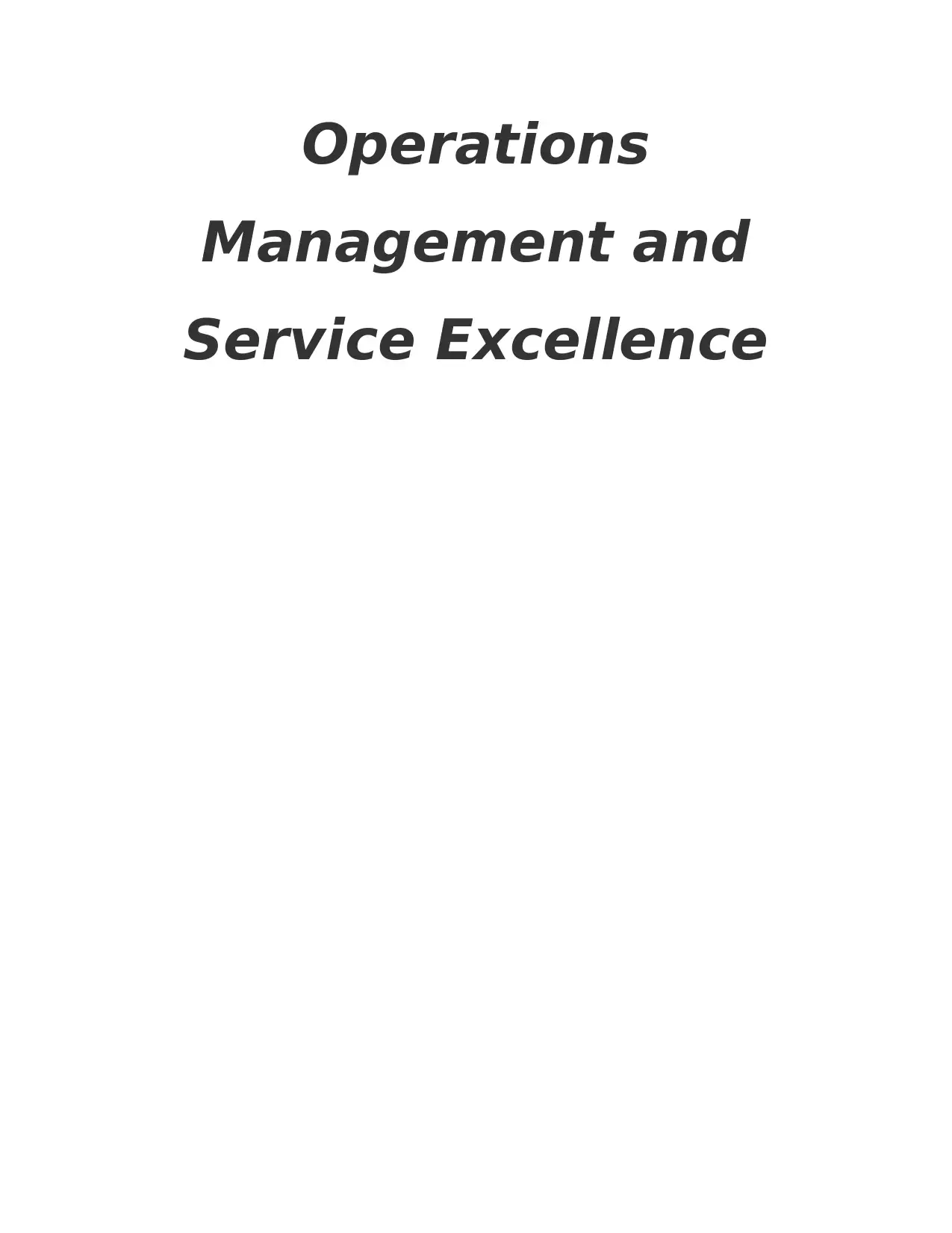
Operations
Management and
Service Excellence
Management and
Service Excellence
Paraphrase This Document
Need a fresh take? Get an instant paraphrase of this document with our AI Paraphraser
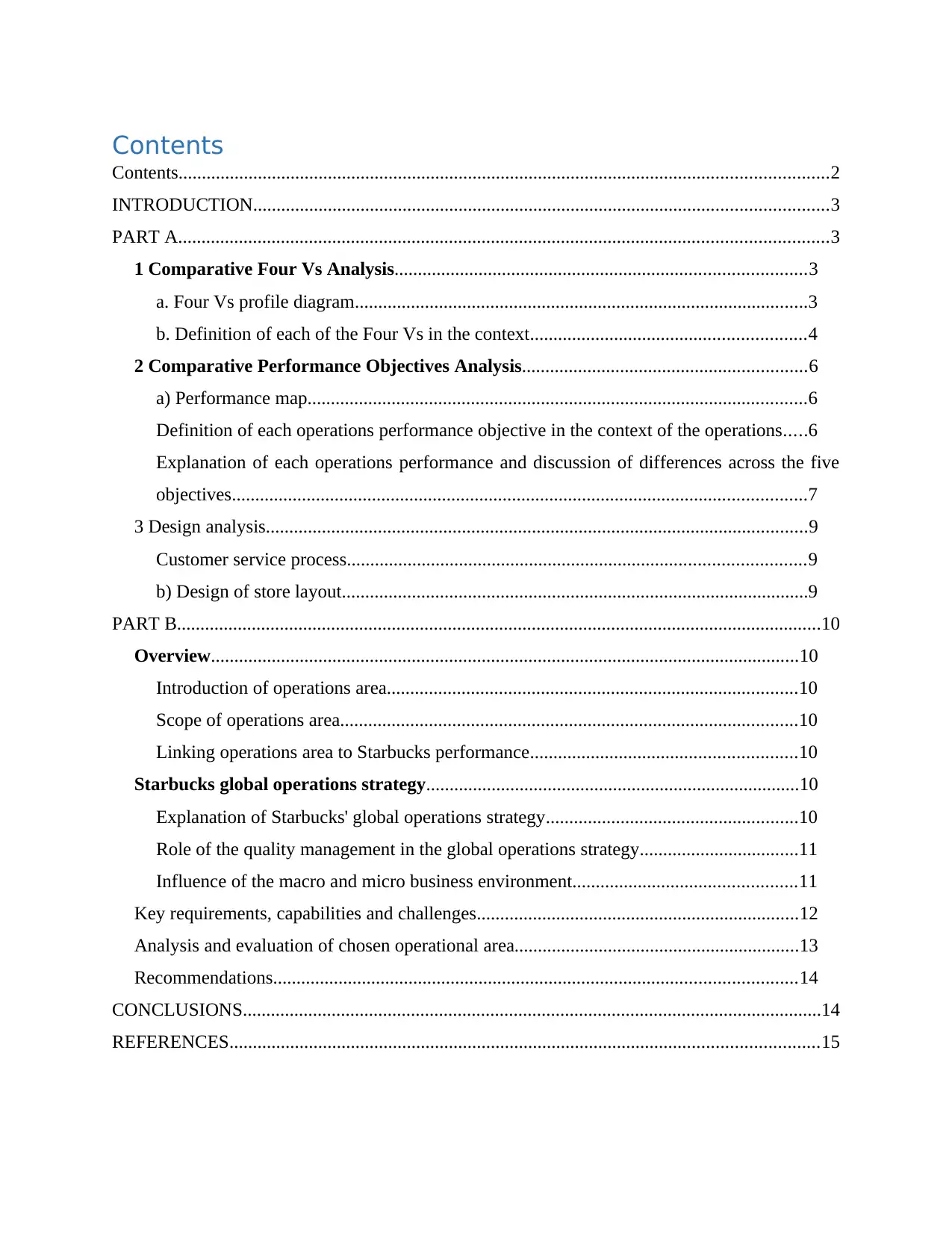
Contents
Contents...........................................................................................................................................2
INTRODUCTION...........................................................................................................................3
PART A...........................................................................................................................................3
1 Comparative Four Vs Analysis........................................................................................3
a. Four Vs profile diagram.................................................................................................3
b. Definition of each of the Four Vs in the context...........................................................4
2 Comparative Performance Objectives Analysis.............................................................6
a) Performance map...........................................................................................................6
Definition of each operations performance objective in the context of the operations.....6
Explanation of each operations performance and discussion of differences across the five
objectives...........................................................................................................................7
3 Design analysis....................................................................................................................9
Customer service process..................................................................................................9
b) Design of store layout....................................................................................................9
PART B..........................................................................................................................................10
Overview..............................................................................................................................10
Introduction of operations area........................................................................................10
Scope of operations area..................................................................................................10
Linking operations area to Starbucks performance.........................................................10
Starbucks global operations strategy................................................................................10
Explanation of Starbucks' global operations strategy......................................................10
Role of the quality management in the global operations strategy..................................11
Influence of the macro and micro business environment................................................11
Key requirements, capabilities and challenges.....................................................................12
Analysis and evaluation of chosen operational area.............................................................13
Recommendations................................................................................................................14
CONCLUSIONS............................................................................................................................14
REFERENCES..............................................................................................................................15
Contents...........................................................................................................................................2
INTRODUCTION...........................................................................................................................3
PART A...........................................................................................................................................3
1 Comparative Four Vs Analysis........................................................................................3
a. Four Vs profile diagram.................................................................................................3
b. Definition of each of the Four Vs in the context...........................................................4
2 Comparative Performance Objectives Analysis.............................................................6
a) Performance map...........................................................................................................6
Definition of each operations performance objective in the context of the operations.....6
Explanation of each operations performance and discussion of differences across the five
objectives...........................................................................................................................7
3 Design analysis....................................................................................................................9
Customer service process..................................................................................................9
b) Design of store layout....................................................................................................9
PART B..........................................................................................................................................10
Overview..............................................................................................................................10
Introduction of operations area........................................................................................10
Scope of operations area..................................................................................................10
Linking operations area to Starbucks performance.........................................................10
Starbucks global operations strategy................................................................................10
Explanation of Starbucks' global operations strategy......................................................10
Role of the quality management in the global operations strategy..................................11
Influence of the macro and micro business environment................................................11
Key requirements, capabilities and challenges.....................................................................12
Analysis and evaluation of chosen operational area.............................................................13
Recommendations................................................................................................................14
CONCLUSIONS............................................................................................................................14
REFERENCES..............................................................................................................................15
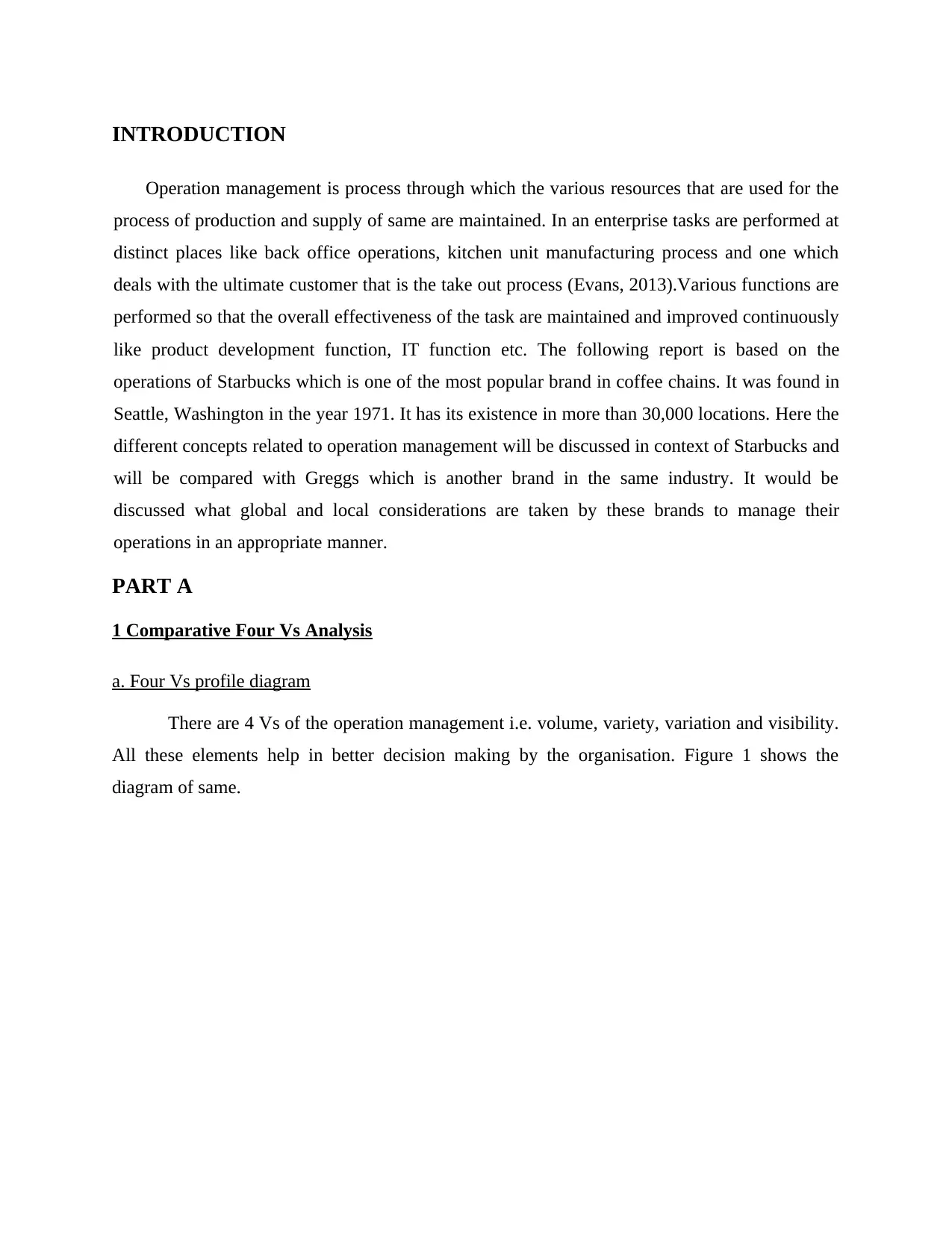
INTRODUCTION
Operation management is process through which the various resources that are used for the
process of production and supply of same are maintained. In an enterprise tasks are performed at
distinct places like back office operations, kitchen unit manufacturing process and one which
deals with the ultimate customer that is the take out process (Evans, 2013).Various functions are
performed so that the overall effectiveness of the task are maintained and improved continuously
like product development function, IT function etc. The following report is based on the
operations of Starbucks which is one of the most popular brand in coffee chains. It was found in
Seattle, Washington in the year 1971. It has its existence in more than 30,000 locations. Here the
different concepts related to operation management will be discussed in context of Starbucks and
will be compared with Greggs which is another brand in the same industry. It would be
discussed what global and local considerations are taken by these brands to manage their
operations in an appropriate manner.
PART A
1 Comparative Four Vs Analysis
a. Four Vs profile diagram
There are 4 Vs of the operation management i.e. volume, variety, variation and visibility.
All these elements help in better decision making by the organisation. Figure 1 shows the
diagram of same.
Operation management is process through which the various resources that are used for the
process of production and supply of same are maintained. In an enterprise tasks are performed at
distinct places like back office operations, kitchen unit manufacturing process and one which
deals with the ultimate customer that is the take out process (Evans, 2013).Various functions are
performed so that the overall effectiveness of the task are maintained and improved continuously
like product development function, IT function etc. The following report is based on the
operations of Starbucks which is one of the most popular brand in coffee chains. It was found in
Seattle, Washington in the year 1971. It has its existence in more than 30,000 locations. Here the
different concepts related to operation management will be discussed in context of Starbucks and
will be compared with Greggs which is another brand in the same industry. It would be
discussed what global and local considerations are taken by these brands to manage their
operations in an appropriate manner.
PART A
1 Comparative Four Vs Analysis
a. Four Vs profile diagram
There are 4 Vs of the operation management i.e. volume, variety, variation and visibility.
All these elements help in better decision making by the organisation. Figure 1 shows the
diagram of same.
⊘ This is a preview!⊘
Do you want full access?
Subscribe today to unlock all pages.

Trusted by 1+ million students worldwide
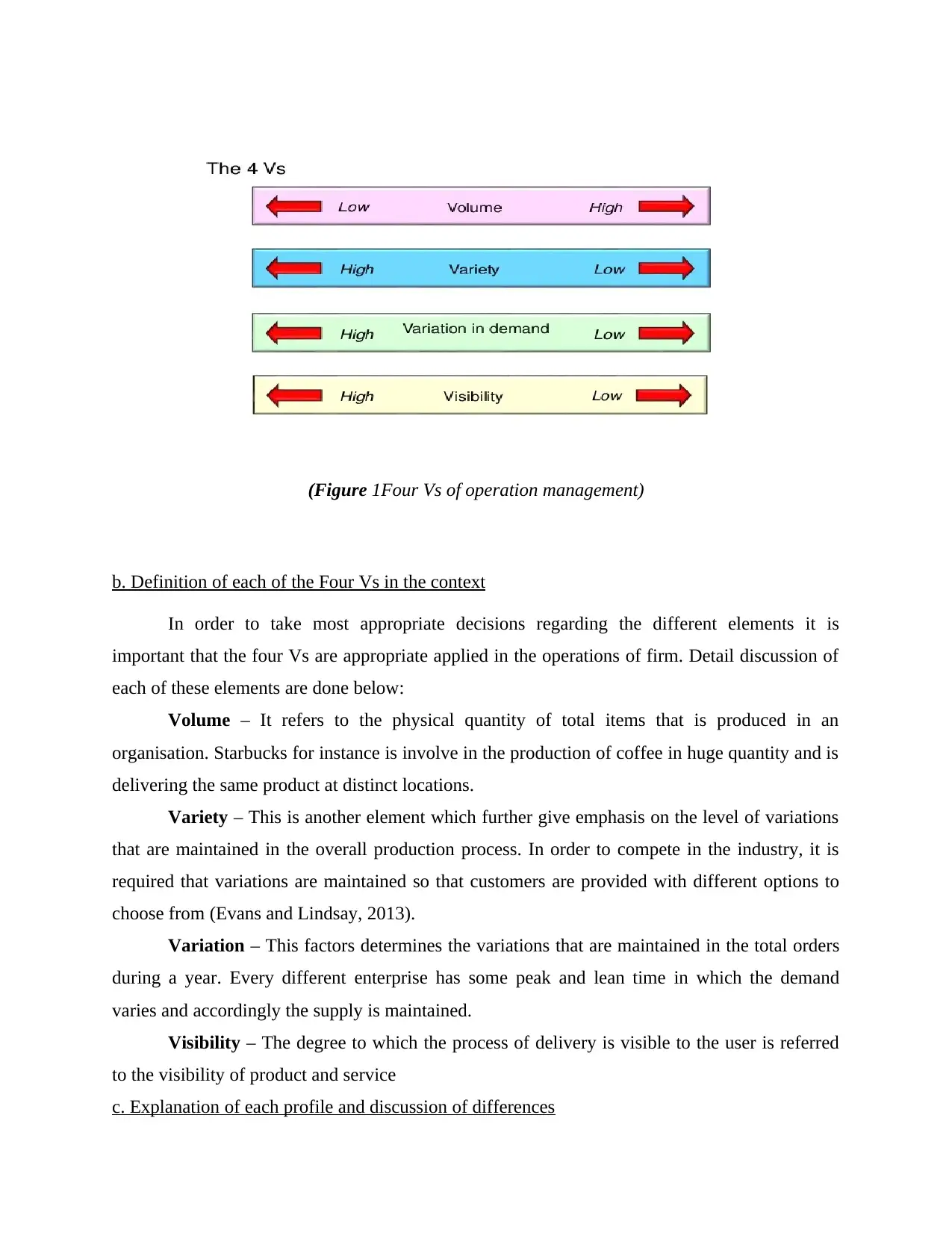
(Figure 1Four Vs of operation management)
b. Definition of each of the Four Vs in the context
In order to take most appropriate decisions regarding the different elements it is
important that the four Vs are appropriate applied in the operations of firm. Detail discussion of
each of these elements are done below:
Volume – It refers to the physical quantity of total items that is produced in an
organisation. Starbucks for instance is involve in the production of coffee in huge quantity and is
delivering the same product at distinct locations.
Variety – This is another element which further give emphasis on the level of variations
that are maintained in the overall production process. In order to compete in the industry, it is
required that variations are maintained so that customers are provided with different options to
choose from (Evans and Lindsay, 2013).
Variation – This factors determines the variations that are maintained in the total orders
during a year. Every different enterprise has some peak and lean time in which the demand
varies and accordingly the supply is maintained.
Visibility – The degree to which the process of delivery is visible to the user is referred
to the visibility of product and service
c. Explanation of each profile and discussion of differences
b. Definition of each of the Four Vs in the context
In order to take most appropriate decisions regarding the different elements it is
important that the four Vs are appropriate applied in the operations of firm. Detail discussion of
each of these elements are done below:
Volume – It refers to the physical quantity of total items that is produced in an
organisation. Starbucks for instance is involve in the production of coffee in huge quantity and is
delivering the same product at distinct locations.
Variety – This is another element which further give emphasis on the level of variations
that are maintained in the overall production process. In order to compete in the industry, it is
required that variations are maintained so that customers are provided with different options to
choose from (Evans and Lindsay, 2013).
Variation – This factors determines the variations that are maintained in the total orders
during a year. Every different enterprise has some peak and lean time in which the demand
varies and accordingly the supply is maintained.
Visibility – The degree to which the process of delivery is visible to the user is referred
to the visibility of product and service
c. Explanation of each profile and discussion of differences
Paraphrase This Document
Need a fresh take? Get an instant paraphrase of this document with our AI Paraphraser
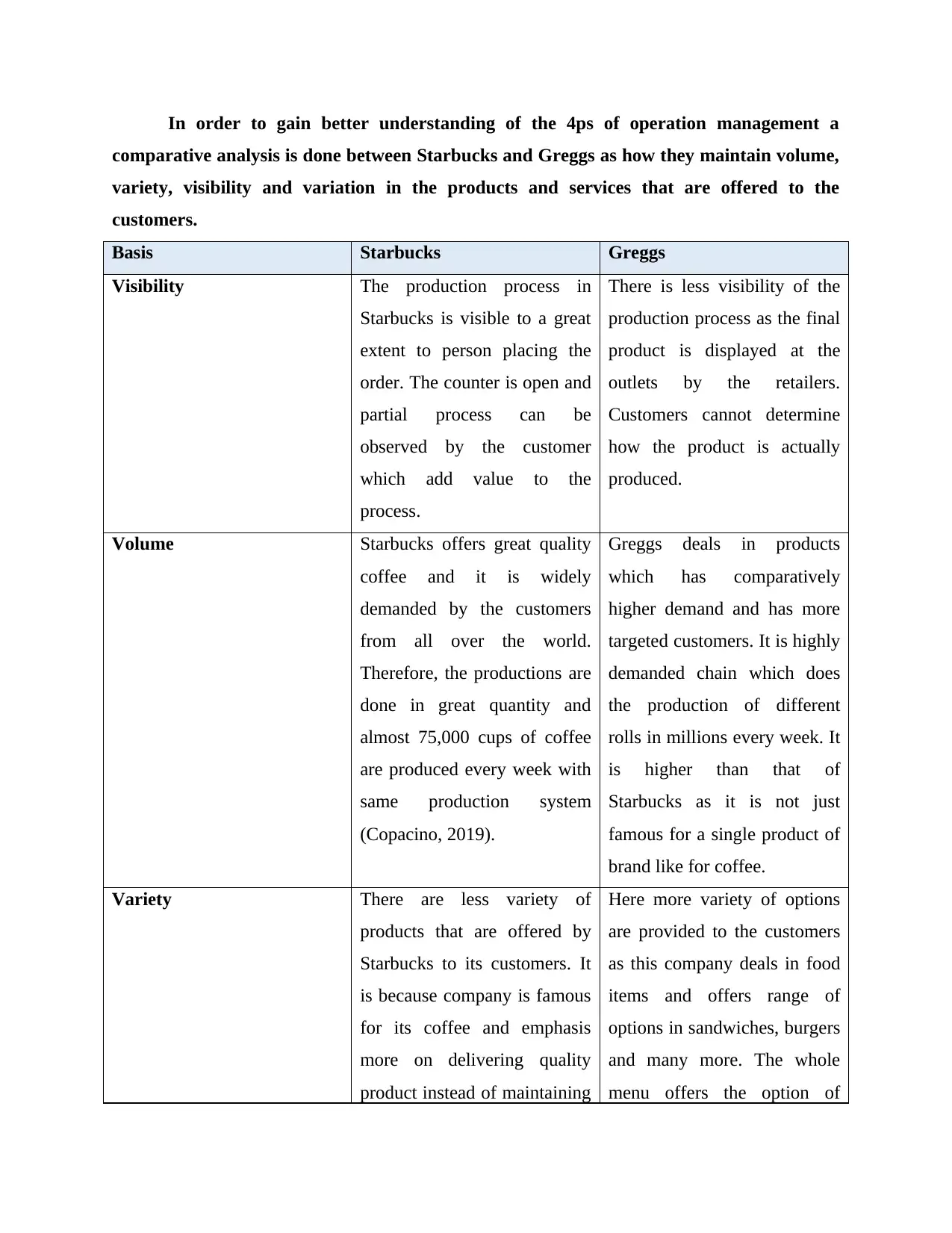
In order to gain better understanding of the 4ps of operation management a
comparative analysis is done between Starbucks and Greggs as how they maintain volume,
variety, visibility and variation in the products and services that are offered to the
customers.
Basis Starbucks Greggs
Visibility The production process in
Starbucks is visible to a great
extent to person placing the
order. The counter is open and
partial process can be
observed by the customer
which add value to the
process.
There is less visibility of the
production process as the final
product is displayed at the
outlets by the retailers.
Customers cannot determine
how the product is actually
produced.
Volume Starbucks offers great quality
coffee and it is widely
demanded by the customers
from all over the world.
Therefore, the productions are
done in great quantity and
almost 75,000 cups of coffee
are produced every week with
same production system
(Copacino, 2019).
Greggs deals in products
which has comparatively
higher demand and has more
targeted customers. It is highly
demanded chain which does
the production of different
rolls in millions every week. It
is higher than that of
Starbucks as it is not just
famous for a single product of
brand like for coffee.
Variety There are less variety of
products that are offered by
Starbucks to its customers. It
is because company is famous
for its coffee and emphasis
more on delivering quality
product instead of maintaining
Here more variety of options
are provided to the customers
as this company deals in food
items and offers range of
options in sandwiches, burgers
and many more. The whole
menu offers the option of
comparative analysis is done between Starbucks and Greggs as how they maintain volume,
variety, visibility and variation in the products and services that are offered to the
customers.
Basis Starbucks Greggs
Visibility The production process in
Starbucks is visible to a great
extent to person placing the
order. The counter is open and
partial process can be
observed by the customer
which add value to the
process.
There is less visibility of the
production process as the final
product is displayed at the
outlets by the retailers.
Customers cannot determine
how the product is actually
produced.
Volume Starbucks offers great quality
coffee and it is widely
demanded by the customers
from all over the world.
Therefore, the productions are
done in great quantity and
almost 75,000 cups of coffee
are produced every week with
same production system
(Copacino, 2019).
Greggs deals in products
which has comparatively
higher demand and has more
targeted customers. It is highly
demanded chain which does
the production of different
rolls in millions every week. It
is higher than that of
Starbucks as it is not just
famous for a single product of
brand like for coffee.
Variety There are less variety of
products that are offered by
Starbucks to its customers. It
is because company is famous
for its coffee and emphasis
more on delivering quality
product instead of maintaining
Here more variety of options
are provided to the customers
as this company deals in food
items and offers range of
options in sandwiches, burgers
and many more. The whole
menu offers the option of
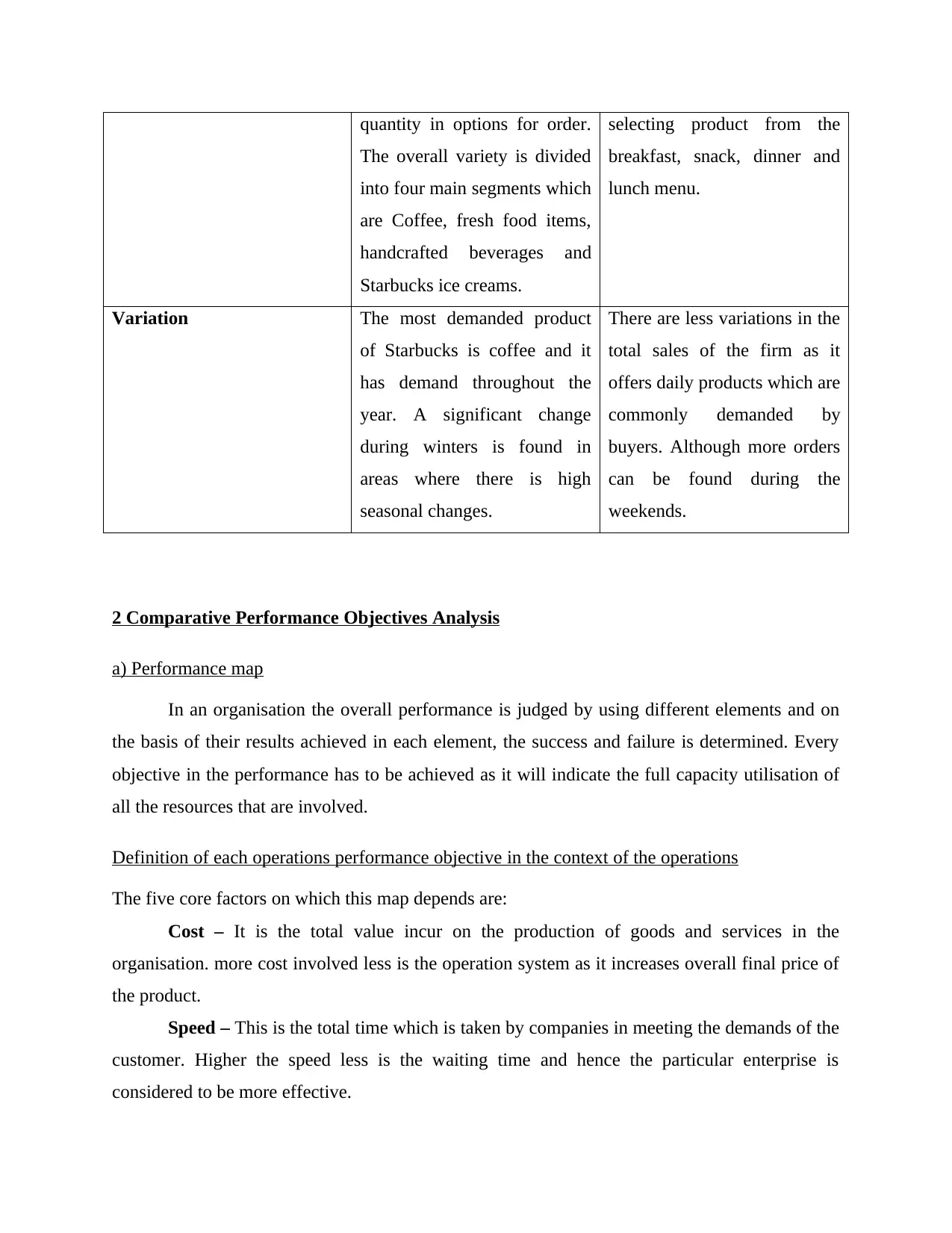
quantity in options for order.
The overall variety is divided
into four main segments which
are Coffee, fresh food items,
handcrafted beverages and
Starbucks ice creams.
selecting product from the
breakfast, snack, dinner and
lunch menu.
Variation The most demanded product
of Starbucks is coffee and it
has demand throughout the
year. A significant change
during winters is found in
areas where there is high
seasonal changes.
There are less variations in the
total sales of the firm as it
offers daily products which are
commonly demanded by
buyers. Although more orders
can be found during the
weekends.
2 Comparative Performance Objectives Analysis
a) Performance map
In an organisation the overall performance is judged by using different elements and on
the basis of their results achieved in each element, the success and failure is determined. Every
objective in the performance has to be achieved as it will indicate the full capacity utilisation of
all the resources that are involved.
Definition of each operations performance objective in the context of the operations
The five core factors on which this map depends are:
Cost – It is the total value incur on the production of goods and services in the
organisation. more cost involved less is the operation system as it increases overall final price of
the product.
Speed – This is the total time which is taken by companies in meeting the demands of the
customer. Higher the speed less is the waiting time and hence the particular enterprise is
considered to be more effective.
The overall variety is divided
into four main segments which
are Coffee, fresh food items,
handcrafted beverages and
Starbucks ice creams.
selecting product from the
breakfast, snack, dinner and
lunch menu.
Variation The most demanded product
of Starbucks is coffee and it
has demand throughout the
year. A significant change
during winters is found in
areas where there is high
seasonal changes.
There are less variations in the
total sales of the firm as it
offers daily products which are
commonly demanded by
buyers. Although more orders
can be found during the
weekends.
2 Comparative Performance Objectives Analysis
a) Performance map
In an organisation the overall performance is judged by using different elements and on
the basis of their results achieved in each element, the success and failure is determined. Every
objective in the performance has to be achieved as it will indicate the full capacity utilisation of
all the resources that are involved.
Definition of each operations performance objective in the context of the operations
The five core factors on which this map depends are:
Cost – It is the total value incur on the production of goods and services in the
organisation. more cost involved less is the operation system as it increases overall final price of
the product.
Speed – This is the total time which is taken by companies in meeting the demands of the
customer. Higher the speed less is the waiting time and hence the particular enterprise is
considered to be more effective.
⊘ This is a preview!⊘
Do you want full access?
Subscribe today to unlock all pages.

Trusted by 1+ million students worldwide
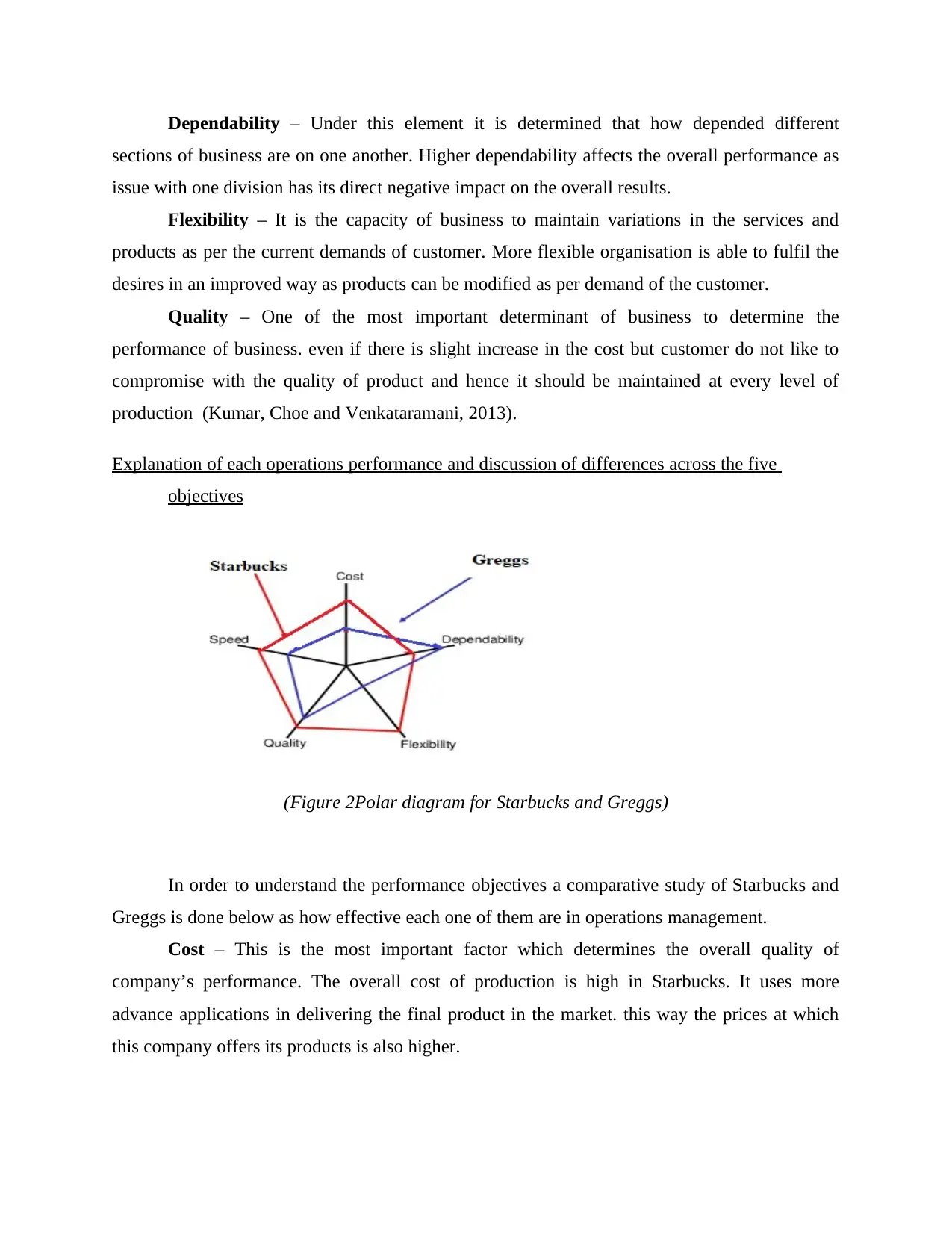
Dependability – Under this element it is determined that how depended different
sections of business are on one another. Higher dependability affects the overall performance as
issue with one division has its direct negative impact on the overall results.
Flexibility – It is the capacity of business to maintain variations in the services and
products as per the current demands of customer. More flexible organisation is able to fulfil the
desires in an improved way as products can be modified as per demand of the customer.
Quality – One of the most important determinant of business to determine the
performance of business. even if there is slight increase in the cost but customer do not like to
compromise with the quality of product and hence it should be maintained at every level of
production (Kumar, Choe and Venkataramani, 2013).
Explanation of each operations performance and discussion of differences across the five
objectives
(Figure 2Polar diagram for Starbucks and Greggs)
In order to understand the performance objectives a comparative study of Starbucks and
Greggs is done below as how effective each one of them are in operations management.
Cost – This is the most important factor which determines the overall quality of
company’s performance. The overall cost of production is high in Starbucks. It uses more
advance applications in delivering the final product in the market. this way the prices at which
this company offers its products is also higher.
sections of business are on one another. Higher dependability affects the overall performance as
issue with one division has its direct negative impact on the overall results.
Flexibility – It is the capacity of business to maintain variations in the services and
products as per the current demands of customer. More flexible organisation is able to fulfil the
desires in an improved way as products can be modified as per demand of the customer.
Quality – One of the most important determinant of business to determine the
performance of business. even if there is slight increase in the cost but customer do not like to
compromise with the quality of product and hence it should be maintained at every level of
production (Kumar, Choe and Venkataramani, 2013).
Explanation of each operations performance and discussion of differences across the five
objectives
(Figure 2Polar diagram for Starbucks and Greggs)
In order to understand the performance objectives a comparative study of Starbucks and
Greggs is done below as how effective each one of them are in operations management.
Cost – This is the most important factor which determines the overall quality of
company’s performance. The overall cost of production is high in Starbucks. It uses more
advance applications in delivering the final product in the market. this way the prices at which
this company offers its products is also higher.
Paraphrase This Document
Need a fresh take? Get an instant paraphrase of this document with our AI Paraphraser
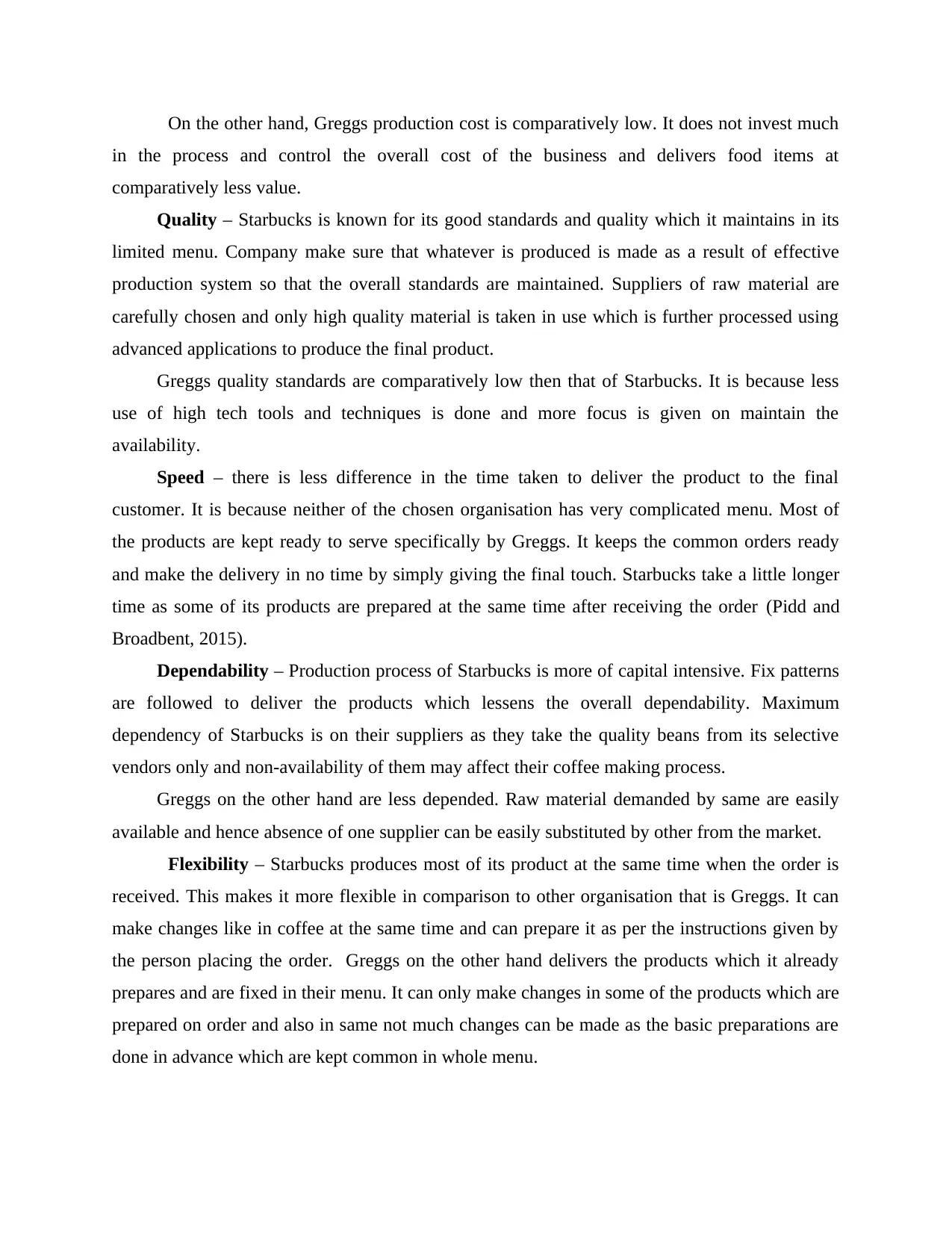
On the other hand, Greggs production cost is comparatively low. It does not invest much
in the process and control the overall cost of the business and delivers food items at
comparatively less value.
Quality – Starbucks is known for its good standards and quality which it maintains in its
limited menu. Company make sure that whatever is produced is made as a result of effective
production system so that the overall standards are maintained. Suppliers of raw material are
carefully chosen and only high quality material is taken in use which is further processed using
advanced applications to produce the final product.
Greggs quality standards are comparatively low then that of Starbucks. It is because less
use of high tech tools and techniques is done and more focus is given on maintain the
availability.
Speed – there is less difference in the time taken to deliver the product to the final
customer. It is because neither of the chosen organisation has very complicated menu. Most of
the products are kept ready to serve specifically by Greggs. It keeps the common orders ready
and make the delivery in no time by simply giving the final touch. Starbucks take a little longer
time as some of its products are prepared at the same time after receiving the order (Pidd and
Broadbent, 2015).
Dependability – Production process of Starbucks is more of capital intensive. Fix patterns
are followed to deliver the products which lessens the overall dependability. Maximum
dependency of Starbucks is on their suppliers as they take the quality beans from its selective
vendors only and non-availability of them may affect their coffee making process.
Greggs on the other hand are less depended. Raw material demanded by same are easily
available and hence absence of one supplier can be easily substituted by other from the market.
Flexibility – Starbucks produces most of its product at the same time when the order is
received. This makes it more flexible in comparison to other organisation that is Greggs. It can
make changes like in coffee at the same time and can prepare it as per the instructions given by
the person placing the order. Greggs on the other hand delivers the products which it already
prepares and are fixed in their menu. It can only make changes in some of the products which are
prepared on order and also in same not much changes can be made as the basic preparations are
done in advance which are kept common in whole menu.
in the process and control the overall cost of the business and delivers food items at
comparatively less value.
Quality – Starbucks is known for its good standards and quality which it maintains in its
limited menu. Company make sure that whatever is produced is made as a result of effective
production system so that the overall standards are maintained. Suppliers of raw material are
carefully chosen and only high quality material is taken in use which is further processed using
advanced applications to produce the final product.
Greggs quality standards are comparatively low then that of Starbucks. It is because less
use of high tech tools and techniques is done and more focus is given on maintain the
availability.
Speed – there is less difference in the time taken to deliver the product to the final
customer. It is because neither of the chosen organisation has very complicated menu. Most of
the products are kept ready to serve specifically by Greggs. It keeps the common orders ready
and make the delivery in no time by simply giving the final touch. Starbucks take a little longer
time as some of its products are prepared at the same time after receiving the order (Pidd and
Broadbent, 2015).
Dependability – Production process of Starbucks is more of capital intensive. Fix patterns
are followed to deliver the products which lessens the overall dependability. Maximum
dependency of Starbucks is on their suppliers as they take the quality beans from its selective
vendors only and non-availability of them may affect their coffee making process.
Greggs on the other hand are less depended. Raw material demanded by same are easily
available and hence absence of one supplier can be easily substituted by other from the market.
Flexibility – Starbucks produces most of its product at the same time when the order is
received. This makes it more flexible in comparison to other organisation that is Greggs. It can
make changes like in coffee at the same time and can prepare it as per the instructions given by
the person placing the order. Greggs on the other hand delivers the products which it already
prepares and are fixed in their menu. It can only make changes in some of the products which are
prepared on order and also in same not much changes can be made as the basic preparations are
done in advance which are kept common in whole menu.
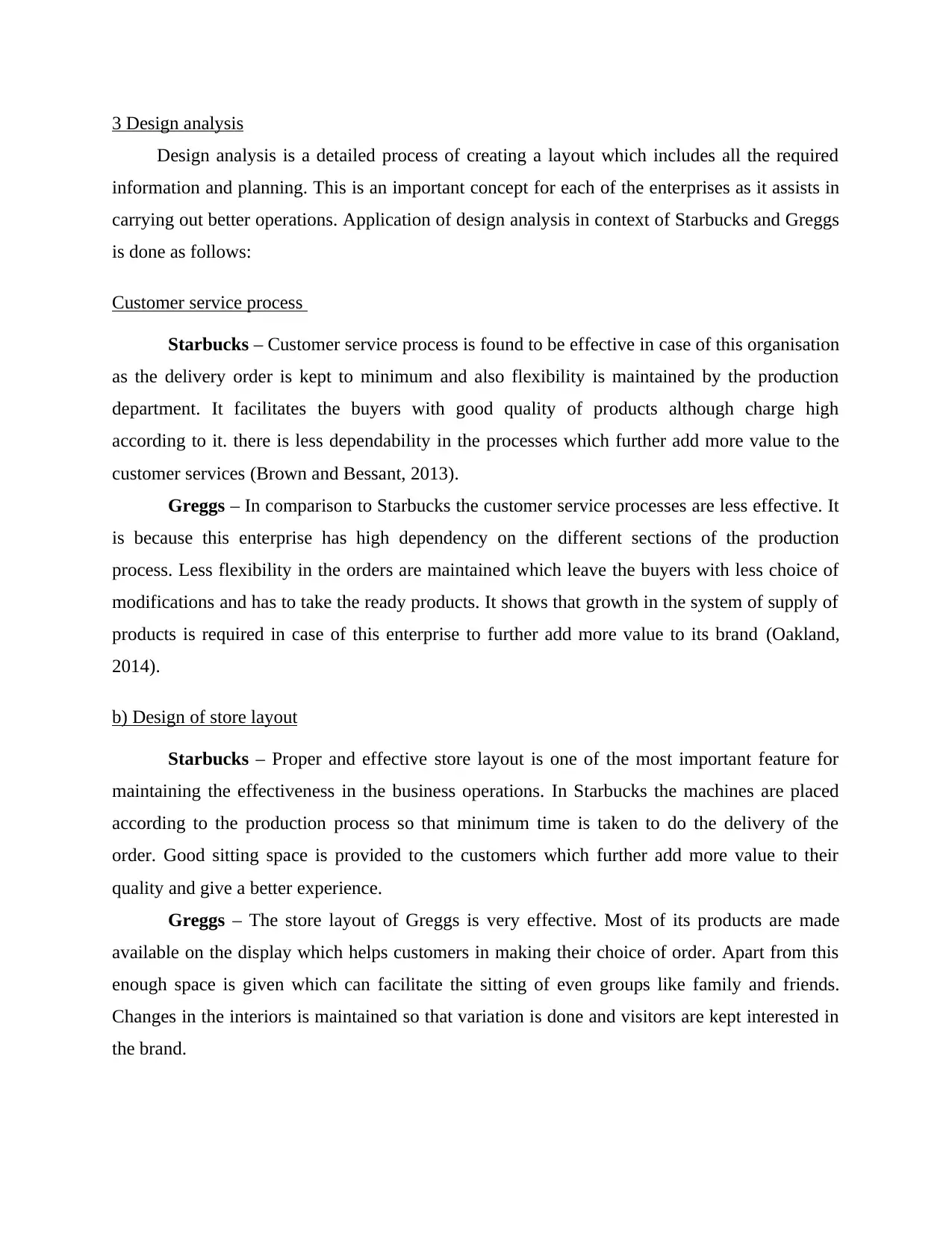
3 Design analysis
Design analysis is a detailed process of creating a layout which includes all the required
information and planning. This is an important concept for each of the enterprises as it assists in
carrying out better operations. Application of design analysis in context of Starbucks and Greggs
is done as follows:
Customer service process
Starbucks – Customer service process is found to be effective in case of this organisation
as the delivery order is kept to minimum and also flexibility is maintained by the production
department. It facilitates the buyers with good quality of products although charge high
according to it. there is less dependability in the processes which further add more value to the
customer services (Brown and Bessant, 2013).
Greggs – In comparison to Starbucks the customer service processes are less effective. It
is because this enterprise has high dependency on the different sections of the production
process. Less flexibility in the orders are maintained which leave the buyers with less choice of
modifications and has to take the ready products. It shows that growth in the system of supply of
products is required in case of this enterprise to further add more value to its brand (Oakland,
2014).
b) Design of store layout
Starbucks – Proper and effective store layout is one of the most important feature for
maintaining the effectiveness in the business operations. In Starbucks the machines are placed
according to the production process so that minimum time is taken to do the delivery of the
order. Good sitting space is provided to the customers which further add more value to their
quality and give a better experience.
Greggs – The store layout of Greggs is very effective. Most of its products are made
available on the display which helps customers in making their choice of order. Apart from this
enough space is given which can facilitate the sitting of even groups like family and friends.
Changes in the interiors is maintained so that variation is done and visitors are kept interested in
the brand.
Design analysis is a detailed process of creating a layout which includes all the required
information and planning. This is an important concept for each of the enterprises as it assists in
carrying out better operations. Application of design analysis in context of Starbucks and Greggs
is done as follows:
Customer service process
Starbucks – Customer service process is found to be effective in case of this organisation
as the delivery order is kept to minimum and also flexibility is maintained by the production
department. It facilitates the buyers with good quality of products although charge high
according to it. there is less dependability in the processes which further add more value to the
customer services (Brown and Bessant, 2013).
Greggs – In comparison to Starbucks the customer service processes are less effective. It
is because this enterprise has high dependency on the different sections of the production
process. Less flexibility in the orders are maintained which leave the buyers with less choice of
modifications and has to take the ready products. It shows that growth in the system of supply of
products is required in case of this enterprise to further add more value to its brand (Oakland,
2014).
b) Design of store layout
Starbucks – Proper and effective store layout is one of the most important feature for
maintaining the effectiveness in the business operations. In Starbucks the machines are placed
according to the production process so that minimum time is taken to do the delivery of the
order. Good sitting space is provided to the customers which further add more value to their
quality and give a better experience.
Greggs – The store layout of Greggs is very effective. Most of its products are made
available on the display which helps customers in making their choice of order. Apart from this
enough space is given which can facilitate the sitting of even groups like family and friends.
Changes in the interiors is maintained so that variation is done and visitors are kept interested in
the brand.
⊘ This is a preview!⊘
Do you want full access?
Subscribe today to unlock all pages.

Trusted by 1+ million students worldwide
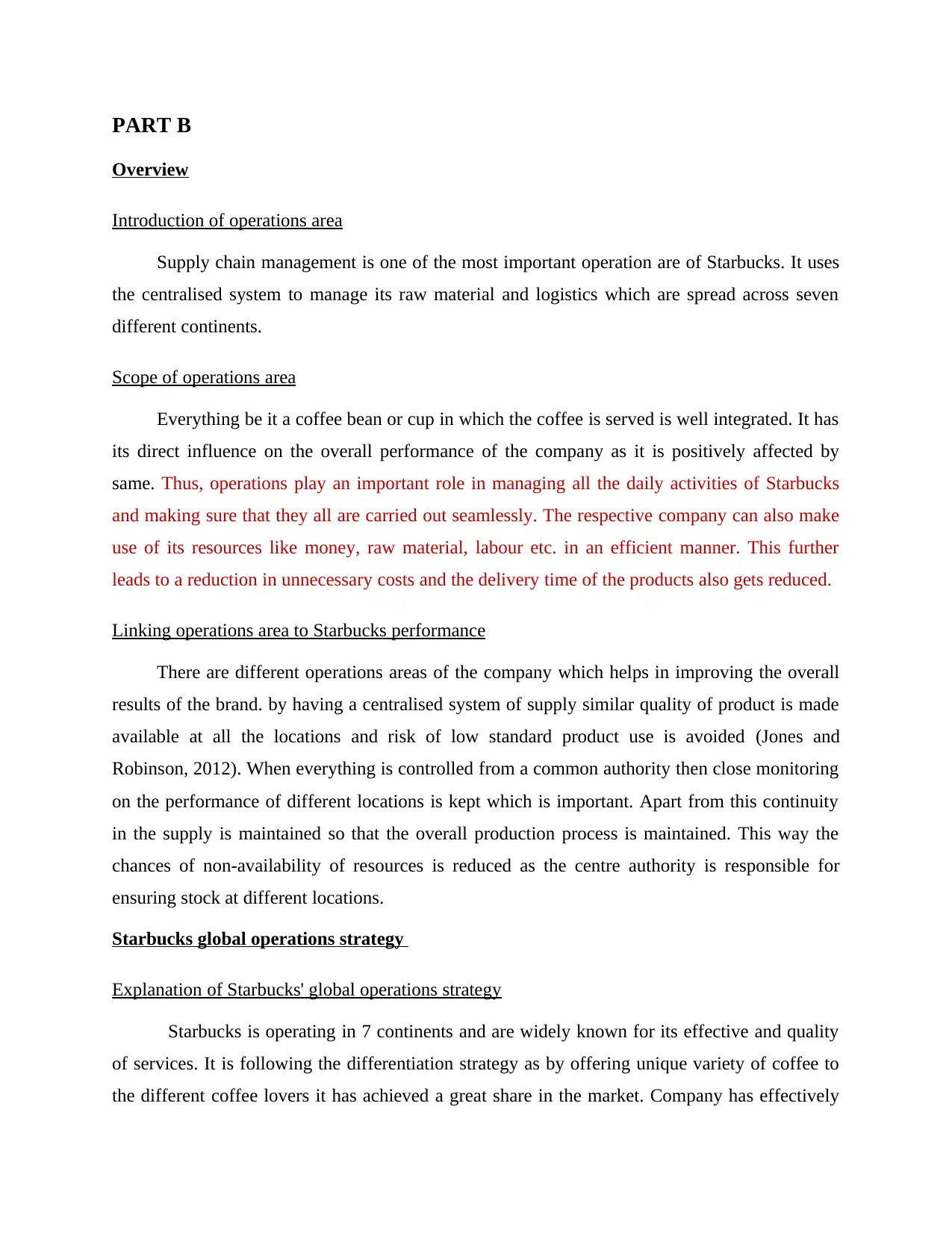
PART B
Overview
Introduction of operations area
Supply chain management is one of the most important operation are of Starbucks. It uses
the centralised system to manage its raw material and logistics which are spread across seven
different continents.
Scope of operations area
Everything be it a coffee bean or cup in which the coffee is served is well integrated. It has
its direct influence on the overall performance of the company as it is positively affected by
same. Thus, operations play an important role in managing all the daily activities of Starbucks
and making sure that they all are carried out seamlessly. The respective company can also make
use of its resources like money, raw material, labour etc. in an efficient manner. This further
leads to a reduction in unnecessary costs and the delivery time of the products also gets reduced.
Linking operations area to Starbucks performance
There are different operations areas of the company which helps in improving the overall
results of the brand. by having a centralised system of supply similar quality of product is made
available at all the locations and risk of low standard product use is avoided (Jones and
Robinson, 2012). When everything is controlled from a common authority then close monitoring
on the performance of different locations is kept which is important. Apart from this continuity
in the supply is maintained so that the overall production process is maintained. This way the
chances of non-availability of resources is reduced as the centre authority is responsible for
ensuring stock at different locations.
Starbucks global operations strategy
Explanation of Starbucks' global operations strategy
Starbucks is operating in 7 continents and are widely known for its effective and quality
of services. It is following the differentiation strategy as by offering unique variety of coffee to
the different coffee lovers it has achieved a great share in the market. Company has effectively
Overview
Introduction of operations area
Supply chain management is one of the most important operation are of Starbucks. It uses
the centralised system to manage its raw material and logistics which are spread across seven
different continents.
Scope of operations area
Everything be it a coffee bean or cup in which the coffee is served is well integrated. It has
its direct influence on the overall performance of the company as it is positively affected by
same. Thus, operations play an important role in managing all the daily activities of Starbucks
and making sure that they all are carried out seamlessly. The respective company can also make
use of its resources like money, raw material, labour etc. in an efficient manner. This further
leads to a reduction in unnecessary costs and the delivery time of the products also gets reduced.
Linking operations area to Starbucks performance
There are different operations areas of the company which helps in improving the overall
results of the brand. by having a centralised system of supply similar quality of product is made
available at all the locations and risk of low standard product use is avoided (Jones and
Robinson, 2012). When everything is controlled from a common authority then close monitoring
on the performance of different locations is kept which is important. Apart from this continuity
in the supply is maintained so that the overall production process is maintained. This way the
chances of non-availability of resources is reduced as the centre authority is responsible for
ensuring stock at different locations.
Starbucks global operations strategy
Explanation of Starbucks' global operations strategy
Starbucks is operating in 7 continents and are widely known for its effective and quality
of services. It is following the differentiation strategy as by offering unique variety of coffee to
the different coffee lovers it has achieved a great share in the market. Company has effectively
Paraphrase This Document
Need a fresh take? Get an instant paraphrase of this document with our AI Paraphraser
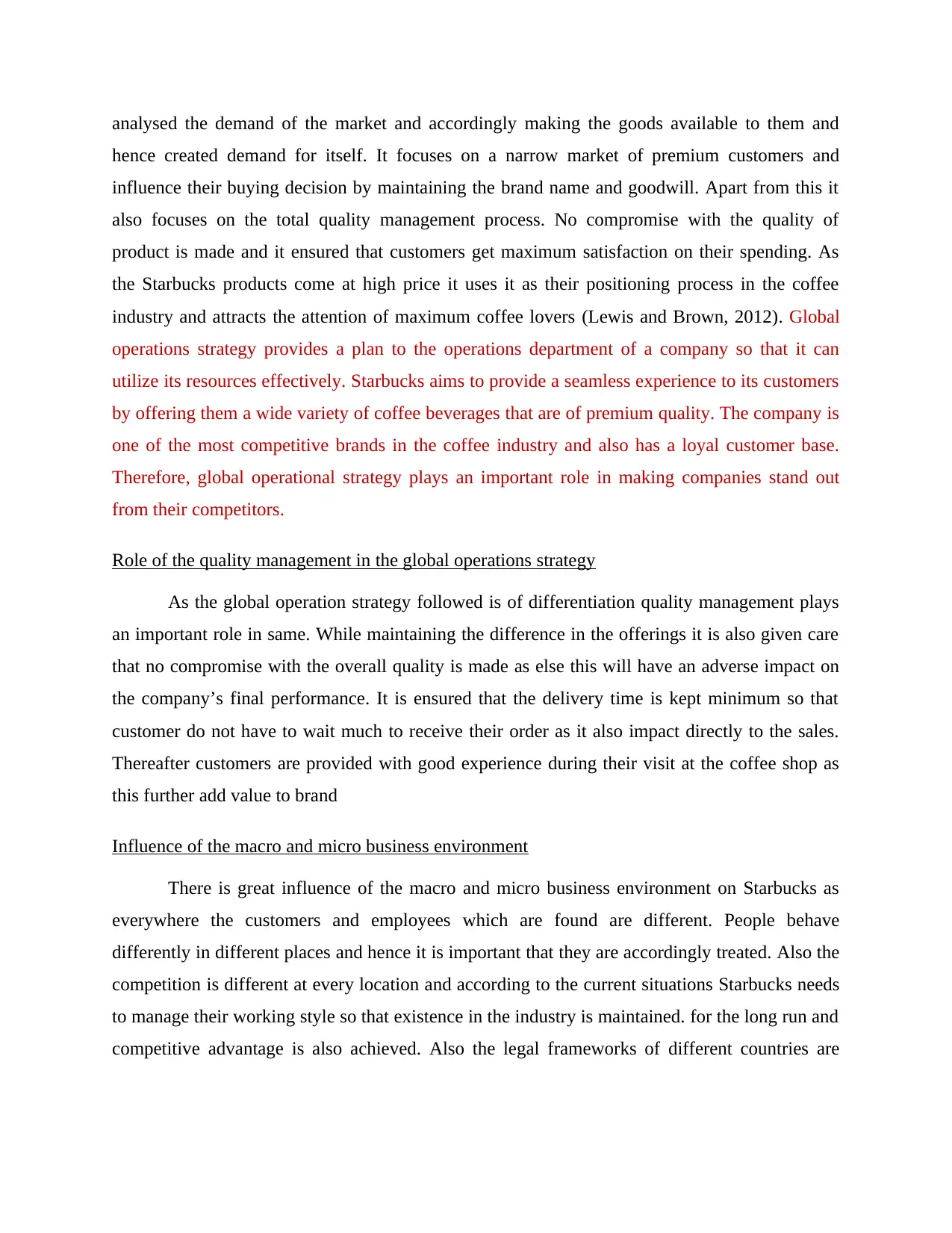
analysed the demand of the market and accordingly making the goods available to them and
hence created demand for itself. It focuses on a narrow market of premium customers and
influence their buying decision by maintaining the brand name and goodwill. Apart from this it
also focuses on the total quality management process. No compromise with the quality of
product is made and it ensured that customers get maximum satisfaction on their spending. As
the Starbucks products come at high price it uses it as their positioning process in the coffee
industry and attracts the attention of maximum coffee lovers (Lewis and Brown, 2012). Global
operations strategy provides a plan to the operations department of a company so that it can
utilize its resources effectively. Starbucks aims to provide a seamless experience to its customers
by offering them a wide variety of coffee beverages that are of premium quality. The company is
one of the most competitive brands in the coffee industry and also has a loyal customer base.
Therefore, global operational strategy plays an important role in making companies stand out
from their competitors.
Role of the quality management in the global operations strategy
As the global operation strategy followed is of differentiation quality management plays
an important role in same. While maintaining the difference in the offerings it is also given care
that no compromise with the overall quality is made as else this will have an adverse impact on
the company’s final performance. It is ensured that the delivery time is kept minimum so that
customer do not have to wait much to receive their order as it also impact directly to the sales.
Thereafter customers are provided with good experience during their visit at the coffee shop as
this further add value to brand
Influence of the macro and micro business environment
There is great influence of the macro and micro business environment on Starbucks as
everywhere the customers and employees which are found are different. People behave
differently in different places and hence it is important that they are accordingly treated. Also the
competition is different at every location and according to the current situations Starbucks needs
to manage their working style so that existence in the industry is maintained. for the long run and
competitive advantage is also achieved. Also the legal frameworks of different countries are
hence created demand for itself. It focuses on a narrow market of premium customers and
influence their buying decision by maintaining the brand name and goodwill. Apart from this it
also focuses on the total quality management process. No compromise with the quality of
product is made and it ensured that customers get maximum satisfaction on their spending. As
the Starbucks products come at high price it uses it as their positioning process in the coffee
industry and attracts the attention of maximum coffee lovers (Lewis and Brown, 2012). Global
operations strategy provides a plan to the operations department of a company so that it can
utilize its resources effectively. Starbucks aims to provide a seamless experience to its customers
by offering them a wide variety of coffee beverages that are of premium quality. The company is
one of the most competitive brands in the coffee industry and also has a loyal customer base.
Therefore, global operational strategy plays an important role in making companies stand out
from their competitors.
Role of the quality management in the global operations strategy
As the global operation strategy followed is of differentiation quality management plays
an important role in same. While maintaining the difference in the offerings it is also given care
that no compromise with the overall quality is made as else this will have an adverse impact on
the company’s final performance. It is ensured that the delivery time is kept minimum so that
customer do not have to wait much to receive their order as it also impact directly to the sales.
Thereafter customers are provided with good experience during their visit at the coffee shop as
this further add value to brand
Influence of the macro and micro business environment
There is great influence of the macro and micro business environment on Starbucks as
everywhere the customers and employees which are found are different. People behave
differently in different places and hence it is important that they are accordingly treated. Also the
competition is different at every location and according to the current situations Starbucks needs
to manage their working style so that existence in the industry is maintained. for the long run and
competitive advantage is also achieved. Also the legal frameworks of different countries are
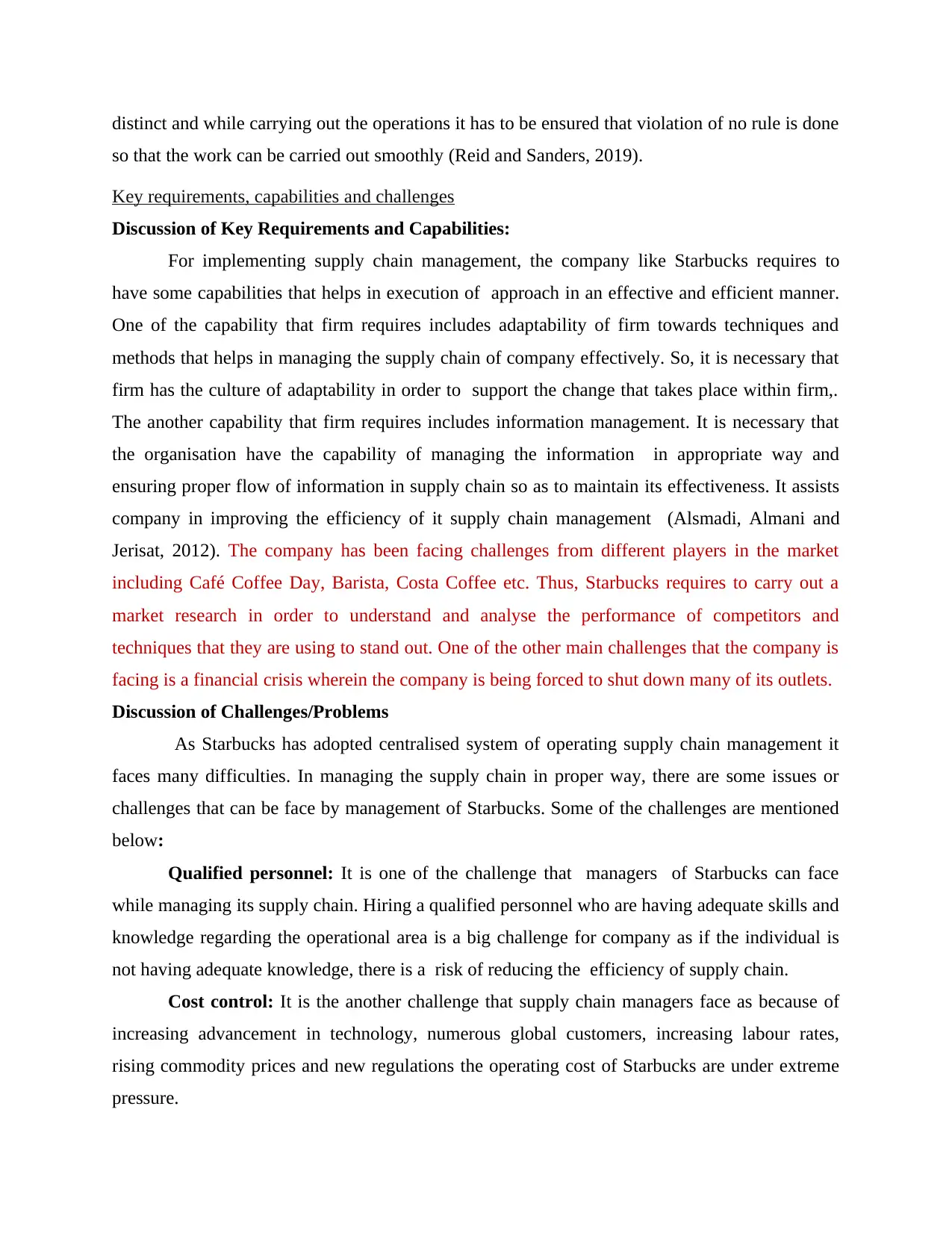
distinct and while carrying out the operations it has to be ensured that violation of no rule is done
so that the work can be carried out smoothly (Reid and Sanders, 2019).
Key requirements, capabilities and challenges
Discussion of Key Requirements and Capabilities:
For implementing supply chain management, the company like Starbucks requires to
have some capabilities that helps in execution of approach in an effective and efficient manner.
One of the capability that firm requires includes adaptability of firm towards techniques and
methods that helps in managing the supply chain of company effectively. So, it is necessary that
firm has the culture of adaptability in order to support the change that takes place within firm,.
The another capability that firm requires includes information management. It is necessary that
the organisation have the capability of managing the information in appropriate way and
ensuring proper flow of information in supply chain so as to maintain its effectiveness. It assists
company in improving the efficiency of it supply chain management (Alsmadi, Almani and
Jerisat, 2012). The company has been facing challenges from different players in the market
including Café Coffee Day, Barista, Costa Coffee etc. Thus, Starbucks requires to carry out a
market research in order to understand and analyse the performance of competitors and
techniques that they are using to stand out. One of the other main challenges that the company is
facing is a financial crisis wherein the company is being forced to shut down many of its outlets.
Discussion of Challenges/Problems
As Starbucks has adopted centralised system of operating supply chain management it
faces many difficulties. In managing the supply chain in proper way, there are some issues or
challenges that can be face by management of Starbucks. Some of the challenges are mentioned
below:
Qualified personnel: It is one of the challenge that managers of Starbucks can face
while managing its supply chain. Hiring a qualified personnel who are having adequate skills and
knowledge regarding the operational area is a big challenge for company as if the individual is
not having adequate knowledge, there is a risk of reducing the efficiency of supply chain.
Cost control: It is the another challenge that supply chain managers face as because of
increasing advancement in technology, numerous global customers, increasing labour rates,
rising commodity prices and new regulations the operating cost of Starbucks are under extreme
pressure.
so that the work can be carried out smoothly (Reid and Sanders, 2019).
Key requirements, capabilities and challenges
Discussion of Key Requirements and Capabilities:
For implementing supply chain management, the company like Starbucks requires to
have some capabilities that helps in execution of approach in an effective and efficient manner.
One of the capability that firm requires includes adaptability of firm towards techniques and
methods that helps in managing the supply chain of company effectively. So, it is necessary that
firm has the culture of adaptability in order to support the change that takes place within firm,.
The another capability that firm requires includes information management. It is necessary that
the organisation have the capability of managing the information in appropriate way and
ensuring proper flow of information in supply chain so as to maintain its effectiveness. It assists
company in improving the efficiency of it supply chain management (Alsmadi, Almani and
Jerisat, 2012). The company has been facing challenges from different players in the market
including Café Coffee Day, Barista, Costa Coffee etc. Thus, Starbucks requires to carry out a
market research in order to understand and analyse the performance of competitors and
techniques that they are using to stand out. One of the other main challenges that the company is
facing is a financial crisis wherein the company is being forced to shut down many of its outlets.
Discussion of Challenges/Problems
As Starbucks has adopted centralised system of operating supply chain management it
faces many difficulties. In managing the supply chain in proper way, there are some issues or
challenges that can be face by management of Starbucks. Some of the challenges are mentioned
below:
Qualified personnel: It is one of the challenge that managers of Starbucks can face
while managing its supply chain. Hiring a qualified personnel who are having adequate skills and
knowledge regarding the operational area is a big challenge for company as if the individual is
not having adequate knowledge, there is a risk of reducing the efficiency of supply chain.
Cost control: It is the another challenge that supply chain managers face as because of
increasing advancement in technology, numerous global customers, increasing labour rates,
rising commodity prices and new regulations the operating cost of Starbucks are under extreme
pressure.
⊘ This is a preview!⊘
Do you want full access?
Subscribe today to unlock all pages.

Trusted by 1+ million students worldwide
1 out of 16
Related Documents
Your All-in-One AI-Powered Toolkit for Academic Success.
+13062052269
info@desklib.com
Available 24*7 on WhatsApp / Email
![[object Object]](/_next/static/media/star-bottom.7253800d.svg)
Unlock your academic potential
Copyright © 2020–2025 A2Z Services. All Rights Reserved. Developed and managed by ZUCOL.





